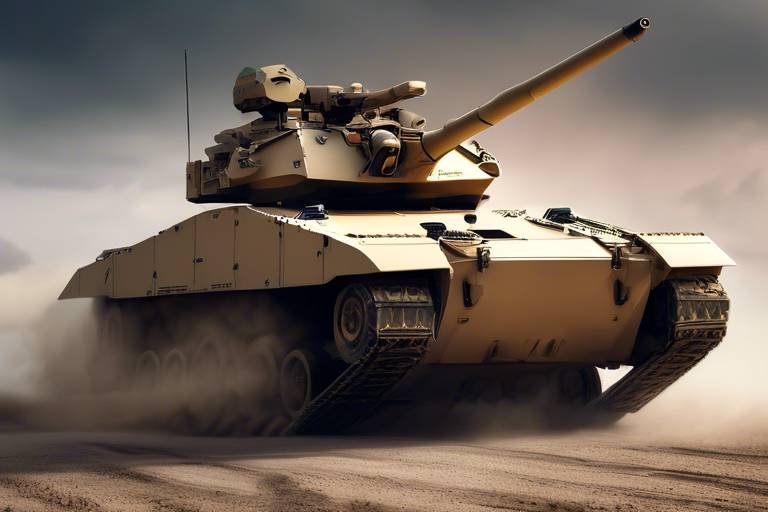Autonomous Artillery Systems - Precision and Speed in Combat
The landscape of modern warfare is changing rapidly, and at the forefront of this transformation are autonomous artillery systems. These advanced systems, equipped with cutting-edge technologies, are designed to enhance both the precision and speed of military operations. Imagine a battlefield where artillery can engage targets with pinpoint accuracy, all while reducing the time it takes to respond to threats. This is not science fiction; it’s the reality of modern combat, where the integration of artificial intelligence and automation is revolutionizing how military forces operate.
As we delve into the evolution of artillery technology, it’s essential to recognize that the journey from traditional artillery methods to autonomous systems has been marked by significant advancements. The early days of artillery involved manual calculations and human operators, often resulting in delays and inaccuracies. However, with the advent of smart technologies, we now have systems that can analyze data in real-time, make decisions, and execute fire missions with minimal human intervention.
But what exactly makes these systems so effective? At their core, autonomous artillery systems rely on a combination of sophisticated sensor technologies, advanced targeting algorithms, and robust communication systems. These components work together to create a seamless operational framework that enhances combat efficiency. For instance, sensor technologies gather crucial data about the battlefield environment, allowing for better target identification and tracking. Meanwhile, targeting algorithms calculate the optimal firing solution, ensuring that each shot is as accurate as possible.
One of the most significant benefits of these systems is the increase in operational efficiency. By automating various processes, military personnel can make faster and more informed decisions. This not only enhances the effectiveness of artillery operations but also allows for a quicker response to emerging threats. Furthermore, the ability to operate remotely means that human soldiers are kept out of harm's way, significantly enhancing their safety during high-risk operations.
However, the rise of autonomous artillery systems is not without its challenges. Ethical considerations come into play when discussing the implications of delegating lethal force to machines. Questions arise about accountability and the moral responsibilities of those who deploy such systems. Additionally, technological limitations, such as reliance on GPS and vulnerability to jamming, pose significant hurdles that need to be addressed to ensure reliability in diverse combat environments.
Looking to the future, the potential of autonomous artillery systems appears boundless. Ongoing research is focused on enhancing these systems' capabilities, improving their integration with other military technologies, and addressing the ethical dilemmas they present. As we continue to explore the intersection of technology and warfare, it is clear that autonomous artillery systems will play a pivotal role in shaping the future of military operations.
- What are autonomous artillery systems?
These are advanced artillery systems that utilize automation and artificial intelligence to enhance precision and speed in combat. - How do sensor technologies improve artillery operations?
Sensor technologies provide real-time data for targeting and navigation, ensuring accuracy and effectiveness in various combat scenarios. - What are the ethical concerns surrounding autonomous artillery?
The use of machines to make life-and-death decisions raises questions about accountability and moral implications. - What is the future of autonomous artillery systems?
Research is ongoing to improve their capabilities, integration with other technologies, and address ethical challenges.

Evolution of Artillery Technology
The evolution of artillery technology is a fascinating journey that mirrors the broader advancements in military strategy and engineering. From the rudimentary catapults of ancient times to the sophisticated autonomous systems of today, artillery has undergone a dramatic transformation. In the early days, artillery was primarily a means to breach fortifications, relying heavily on brute force and the skill of the operators. However, as warfare evolved, so did the need for greater precision and efficiency.
During the 19th century, the introduction of rifled barrels and explosive shells marked a significant leap forward. These innovations allowed for greater range and accuracy, fundamentally changing how battles were fought. Fast forward to the 20th century, and we see the emergence of mechanized artillery, which could be rapidly deployed and repositioned, offering unprecedented flexibility on the battlefield. The World Wars catalyzed a race for artillery supremacy, leading to advancements in projectile design, range, and fire control systems.
Today, we stand at the precipice of a new era in artillery technology, characterized by the integration of autonomous systems. These systems leverage cutting-edge technologies such as artificial intelligence, advanced sensors, and real-time data analytics. The shift toward autonomy in artillery systems is not just about replacing human operators; it's about enhancing operational speed and precision in combat scenarios.
To understand this evolution, it’s helpful to look at a timeline of key developments in artillery technology:
| Year | Development | Impact |
|---|---|---|
| 400 BC | Invention of the Catapult | Introduced the concept of projectile warfare. |
| 19th Century | Rifled Barrels | Increased accuracy and range of artillery. |
| World War I | Mechanized Artillery | Enhanced mobility and rapid deployment. |
| 21st Century | Autonomous Artillery Systems | Revolutionized combat efficiency and decision-making. |
The advent of autonomous artillery systems has brought about the ability to make split-second decisions based on real-time data, which is crucial in modern warfare. These systems can analyze vast amounts of information, including battlefield conditions, enemy movements, and environmental factors, to optimize firing solutions. This level of sophistication not only increases the effectiveness of artillery units but also significantly reduces the risk of collateral damage.
As we look to the future, the evolution of artillery technology will continue to be shaped by ongoing research and development efforts. The integration of artificial intelligence and machine learning will likely lead to even more advanced targeting algorithms and sensor technologies. The question now is not just how artillery systems will evolve, but how they will redefine the landscape of warfare itself.
- What are autonomous artillery systems? Autonomous artillery systems are advanced military technologies that operate with minimal human intervention, utilizing sensors and algorithms to engage targets with high precision.
- How have artillery systems changed over time? Artillery systems have evolved from simple catapults to complex mechanized and autonomous systems, significantly improving accuracy, range, and operational efficiency.
- What are the benefits of using autonomous artillery? Benefits include increased firepower, reduced response times, and enhanced safety for personnel, as these systems can operate remotely.
- What challenges do autonomous artillery systems face? Challenges include ethical concerns regarding decision-making, technological limitations like GPS reliance, and the need for robust cybersecurity measures.

Key Components of Autonomous Systems
The realm of autonomous artillery systems is not just about firing shells and hitting targets; it's a complex interplay of various technologies that work in harmony to enhance combat efficiency. Understanding these key components is crucial to appreciating how these systems operate and the significant impact they have on modern military strategies. At the heart of these systems lie three essential elements: sensor technologies, targeting algorithms, and communication technologies.
Sensor technologies serve as the eyes and ears of autonomous artillery systems. They gather real-time data that is vital for both navigation and targeting. Imagine trying to hit a moving target without knowing its exact location; that's where sensors come into play. These technologies can include a variety of devices, such as radar systems and optical sensors, each contributing to the overall effectiveness of the artillery system.
Let's delve deeper into the sensor technologies that make these systems tick. Radar systems are integral to the detection and tracking of targets. They enable autonomous artillery units to engage threats with minimal human intervention, significantly improving response times on the battlefield. This capability is akin to having a hawk's vision, allowing the system to spot and track targets from a distance, ensuring that threats are neutralized before they can cause harm. On the other hand, optical sensors provide visual data that enhances situational awareness. These sensors allow autonomous systems to make informed decisions based on the surrounding environment and accurately identify targets. Think of them as the system's pair of eyes, ensuring that it not only sees the target but understands the context in which it operates.
Moving on to targeting algorithms, these advanced computational processes are fundamental for calculating optimal firing solutions. In the chaos of battle, where every second counts, these algorithms ensure that autonomous artillery systems can engage targets with high precision while minimizing collateral damage. They analyze a multitude of variables, such as distance, wind speed, and target movement, to determine the best angle and force for firing. It's like having a master strategist who can quickly assess a battlefield and decide the best course of action in the blink of an eye.
Moreover, the integration of communication technologies is vital for the seamless operation of autonomous artillery systems. These technologies facilitate real-time data sharing between different units, ensuring that all systems are synchronized and can respond to changing battlefield conditions. The ability to communicate effectively can mean the difference between victory and defeat. Imagine a football team where players are not in sync; the chances of scoring a goal are slim. Similarly, in warfare, communication is key to operational success.
| Component | Function |
|---|---|
| Sensor Technologies | Gather real-time data for navigation and targeting |
| Targeting Algorithms | Calculate optimal firing solutions to engage targets |
| Communication Technologies | Facilitate real-time data sharing between units |
In summary, the key components of autonomous artillery systems—sensor technologies, targeting algorithms, and communication technologies—work together to create a formidable force on the battlefield. They not only enhance precision and speed but also revolutionize the way military operations are conducted. As we advance further into the age of technology, understanding these components will be crucial for military strategists and policymakers alike.
- What are autonomous artillery systems? Autonomous artillery systems are advanced military technologies that use sensors, algorithms, and communication systems to operate with minimal human intervention.
- How do sensor technologies improve artillery accuracy? Sensor technologies provide real-time data that helps in accurately targeting and navigating, ensuring effective engagement of threats.
- What ethical concerns are associated with autonomous systems? The use of autonomous systems raises questions about accountability and the moral implications of delegating lethal force to machines.
- What is the future of autonomous artillery? The future looks promising, with ongoing research aimed at enhancing capabilities and addressing the challenges posed by ethical and operational considerations.

Sensor Technologies
In the realm of autonomous artillery systems, are the backbone that powers their operational effectiveness. These sophisticated devices function as the eyes and ears of the artillery units, offering real-time data that is crucial for targeting and navigation. Imagine trying to hit a moving target in a vast battlefield without any visual aid; it would be nearly impossible. This is where sensors come into play, providing invaluable information that enhances accuracy and effectiveness in various combat environments.
One of the primary types of sensors used in these systems is radar systems. These devices are essential for detecting and tracking targets, allowing autonomous artillery units to engage threats with remarkable precision and minimal human intervention. The ability to scan vast areas quickly means that artillery can respond to incoming threats faster than ever before. For instance, a radar system can identify an enemy position, calculate its trajectory, and relay that information to the artillery unit in mere seconds, significantly improving response times on the battlefield.
In addition to radar, optical sensors play a crucial role in enhancing situational awareness. These sensors provide visual data that allows autonomous systems to make informed decisions based on the surrounding environment and target identification. Imagine a soldier peering through binoculars to spot an enemy; optical sensors do this at a much faster rate and with greater accuracy. They can analyze the battlefield in real-time, identifying not only enemy positions but also assessing the terrain, thus aiding in tactical decision-making.
Moreover, the integration of sensor fusion technology is becoming increasingly prevalent. This involves combining data from multiple sensors to create a comprehensive understanding of the battlefield. By synthesizing information from radar, optical, and other sensors, autonomous artillery systems can achieve a higher level of situational awareness. This multi-faceted approach allows for better decision-making and enhances the overall effectiveness of military operations.
As we look towards the future, advancements in sensor technologies will undoubtedly continue to evolve. With ongoing research focusing on improving the sensitivity and accuracy of these devices, we can expect to see even greater enhancements in how autonomous artillery systems operate. The potential for artificial intelligence to analyze sensor data in real-time opens up exciting possibilities for the future of warfare.
- What are the main types of sensors used in autonomous artillery systems?
The primary types include radar systems for tracking and detecting targets and optical sensors for visual data and situational awareness. - How do sensor technologies improve combat efficiency?
They provide real-time data that enhances targeting accuracy and decision-making speed, allowing for quicker responses to threats. - What is sensor fusion?
Sensor fusion is the process of combining data from multiple sensors to create a comprehensive understanding of the battlefield, improving situational awareness. - Will sensor technologies continue to evolve?
Yes, ongoing research is focused on enhancing the sensitivity and accuracy of sensors, which will further improve the capabilities of autonomous artillery systems.

Radar Systems
Radar systems are a cornerstone of modern autonomous artillery systems, acting as the eyes of these advanced machines on the battlefield. Imagine trying to hit a moving target in a game of darts while blindfolded—that's what traditional artillery faced before the advent of radar technology. With radar, autonomous artillery units can detect, track, and engage targets with remarkable accuracy, all while significantly reducing the need for human intervention. This capability not only enhances the speed of response but also transforms how military operations are conducted in real-time.
One of the key advantages of radar systems is their ability to function effectively in various environmental conditions. Whether it's rain, fog, or dust, radar waves can penetrate these obstacles, providing clear data for target acquisition. This is akin to having a superpower that allows you to see through walls! The integration of phased-array radar technology further amplifies this capability, enabling these systems to scan large areas quickly and efficiently, much like a hawk surveying its territory from above.
Moreover, radar systems can be programmed to distinguish between different types of targets, which is crucial in combat scenarios. For instance, they can differentiate between enemy vehicles and civilian objects, minimizing the risk of collateral damage. This is particularly important in today’s warfare, where the lines between combatants and non-combatants can often blur. The ability to make such distinctions is not just a technical feat; it's a vital component of ethical warfare practices.
However, while radar systems offer impressive advantages, they are not without their limitations. For example, reliance on radar can make autonomous artillery systems vulnerable to countermeasures such as jamming and spoofing. This is where the importance of integrating multiple sensor technologies comes into play. By combining radar with optical sensors and other technologies, these systems can create a more robust and resilient operational framework, ensuring they remain effective even in contested environments.
In conclusion, radar systems are indispensable in the realm of autonomous artillery. They provide the precision and speed necessary for modern combat, allowing military forces to engage threats effectively while minimizing risks. As technology continues to evolve, we can expect radar capabilities to become even more sophisticated, further enhancing the operational effectiveness of autonomous systems on the battlefield.
- What are the main functions of radar systems in autonomous artillery?
Radar systems primarily detect and track targets, providing real-time data that enables autonomous artillery to engage threats accurately. - How do radar systems improve operational efficiency?
By allowing for quicker target acquisition and engagement, radar systems significantly reduce response times, enhancing overall combat effectiveness. - What are the limitations of radar systems?
Radar systems can be susceptible to jamming and spoofing, which can hinder their effectiveness in combat scenarios. - Can radar systems operate in adverse weather conditions?
Yes, radar systems are designed to function effectively in various environmental conditions, including rain, fog, and dust.

Optical Sensors
In the realm of autonomous artillery systems, serve as a crucial component that significantly enhances situational awareness and decision-making capabilities. These sensors provide visual data that is essential for identifying targets and assessing the battlefield environment. Imagine being in a dense fog where visibility is nearly zero; without optical sensors, an artillery unit would be like a ship lost at sea, unable to navigate or react effectively. However, with advanced optical technologies, these systems can "see" through the fog, providing a clear view of the battlefield.
Optical sensors utilize a combination of high-resolution cameras, infrared imaging, and night vision capabilities to gather comprehensive visual information. This data is then processed in real-time, allowing autonomous artillery systems to make informed decisions based on the surrounding environment. For instance, during nighttime operations or in low-light conditions, infrared sensors can detect heat signatures, enabling the identification of enemy positions even when traditional visibility is compromised.
Moreover, optical sensors play a pivotal role in target recognition and classification. By employing advanced algorithms, these systems can analyze the visual data captured by the sensors and differentiate between various objects on the battlefield. This capability is vital for minimizing collateral damage and ensuring that the artillery is directed only at legitimate military targets. The ability to distinguish between a tank and a civilian vehicle, for example, can mean the difference between a successful mission and a tragic mistake.
Furthermore, optical sensors contribute to the overall networked warfare environment by integrating with other military technologies. When combined with radar and communication systems, optical sensors enhance the situational awareness of the entire military unit, allowing for coordinated efforts in complex combat scenarios. This interconnectedness not only improves the effectiveness of autonomous artillery systems but also fosters a more strategic approach to military operations.
In conclusion, the integration of optical sensors into autonomous artillery systems is a game-changer in modern warfare. They provide the visual acuity needed to navigate the chaos of the battlefield, ensuring that these systems can operate with a level of precision and effectiveness that was previously unimaginable. As technology continues to evolve, we can expect even more sophisticated optical systems that will further enhance the capabilities of artillery in combat.
- What are optical sensors used for in autonomous artillery systems?
Optical sensors are used for target identification, situational awareness, and enhancing decision-making capabilities by providing real-time visual data. - How do optical sensors improve safety during military operations?
By allowing for accurate target identification and reducing the risk of collateral damage, optical sensors help ensure that artillery systems engage only legitimate military targets. - Can optical sensors operate in low-light conditions?
Yes, many optical sensors are equipped with infrared imaging and night vision technologies, enabling them to function effectively in low-light or nighttime environments. - What is the future of optical sensors in military technology?
The future of optical sensors includes advancements in resolution, processing speed, and integration with other technologies, which will enhance their effectiveness in combat scenarios.

Targeting Algorithms
When we talk about autonomous artillery systems, one of the key players in their success is the sophisticated they employ. These algorithms are the brains behind the operation, enabling these systems to calculate the most effective firing solutions. Imagine trying to hit a moving target while blindfolded; that’s what traditional artillery often felt like. However, with advanced algorithms, it’s like having a GPS that not only shows the route but also predicts traffic patterns and road conditions!
These algorithms utilize a variety of data inputs, such as target location, speed, and environmental conditions, to ensure that the artillery can engage with pinpoint accuracy. For instance, if a target is moving at a certain speed, the algorithm can calculate the lead necessary to ensure the projectile hits its mark. This is particularly crucial in modern warfare, where targets are often not stationary. The precision of these algorithms not only enhances the effectiveness of artillery strikes but also significantly reduces the risk of collateral damage.
To illustrate the importance of targeting algorithms, let's take a look at a simplified comparison of traditional versus autonomous targeting approaches:
| Aspect | Traditional Targeting | Autonomous Targeting |
|---|---|---|
| Data Input | Manual calculations and estimates | Real-time data from sensors and AI analysis |
| Response Time | Slower, due to human involvement | Rapid, with minimal human intervention |
| Accuracy | Variable, often less reliable | High precision with advanced algorithms |
| Collateral Damage | Higher risk | Minimized through precise targeting |
As we delve deeper into the world of military technology, it’s clear that the evolution of targeting algorithms is not just a technical upgrade; it’s a game changer. These algorithms are designed to learn and adapt, meaning that they can improve their accuracy over time. It’s like training a dog: the more you work with it, the better it gets at obeying commands. Similarly, the more data these algorithms process, the more proficient they become at making split-second decisions in complex combat scenarios.
However, it’s essential to remember that while these algorithms enhance operational capabilities, they also come with their own set of challenges. For instance, the reliance on accurate data means that any disruption, such as signal jamming or sensor failure, could compromise the effectiveness of the artillery system. Thus, continuous advancements in technology and robust cybersecurity measures are necessary to ensure these systems function optimally in real-world situations.
- What are targeting algorithms?
Targeting algorithms are advanced calculations used by autonomous artillery systems to determine the best firing solutions based on real-time data. - How do these algorithms improve accuracy?
They analyze multiple variables such as target speed, direction, and environmental conditions to ensure precise targeting. - Are there risks associated with using autonomous targeting systems?
Yes, risks include reliance on technology that can fail or be disrupted, as well as ethical concerns regarding decision-making in combat.

Benefits of Autonomous Artillery
This article explores the evolution, technology, and implications of autonomous artillery systems in modern warfare, highlighting their benefits, challenges, and future potential in enhancing combat efficiency.
The development of artillery systems has undergone significant changes over the decades, transitioning from traditional methods to advanced autonomous technologies that enhance precision and operational speed in combat scenarios.
Understanding the essential components of autonomous artillery systems, including sensors, targeting algorithms, and communication technologies, is crucial for grasping how these systems operate and their impact on military strategy.
Sensor technologies play a vital role in autonomous artillery systems by providing real-time data for targeting and navigation, ensuring accuracy and effectiveness in various combat environments.
Radar systems are integral to detecting and tracking targets, offering autonomous artillery units the ability to engage threats with minimal human intervention, thus improving response times on the battlefield.
Optical sensors enhance situational awareness by providing visual data, allowing autonomous systems to make informed decisions based on the surrounding environment and target identification.
Advanced targeting algorithms are essential for calculating optimal firing solutions, ensuring that autonomous artillery systems can engage targets with high precision while minimizing collateral damage.
The integration of autonomous artillery systems in military operations offers numerous advantages that can profoundly change the landscape of combat. One of the most significant benefits is the increased firepower these systems provide. By automating the targeting and firing processes, military units can unleash a higher volume of fire in a shorter time frame, effectively overwhelming enemy positions.
Moreover, autonomous artillery systems drastically reduce response times. Imagine a scenario where a commander can call for artillery support, and within seconds, the system processes the command, identifies the target, and fires without human delay. This speed can be the difference between victory and defeat on the battlefield.
Another critical advantage is the enhanced safety for personnel. With the ability to operate remotely, autonomous systems significantly mitigate the risks faced by human soldiers. Instead of placing troops in harm’s way to operate artillery, these systems can engage targets from a safe distance, preserving lives in high-risk environments. This not only protects military personnel but also boosts morale, knowing that they have powerful, reliable support without the immediate dangers of combat.
Furthermore, the operational efficiency of these systems cannot be overstated. By automating various processes, autonomous artillery systems streamline operations, allowing for faster decision-making and execution of fire missions. This efficiency translates to a more agile and responsive military force capable of adapting to changing battlefield conditions.
In summary, the benefits of autonomous artillery systems encompass:
- Increased Firepower: Higher volume of fire in shorter time frames.
- Reduced Response Times: Quick processing and engagement of targets.
- Enhanced Safety for Personnel: Minimizing risks to human soldiers.
- Operational Efficiency: Streamlined processes for quicker decision-making.
Despite their advantages, autonomous artillery systems face several challenges, including ethical concerns, technological limitations, and the need for robust cybersecurity measures to prevent potential threats.
The use of autonomous systems in warfare raises ethical questions regarding accountability and decision-making, prompting discussions on the moral implications of delegating lethal force to machines.
Current technological constraints, such as reliance on GPS and susceptibility to jamming, pose significant challenges for the effectiveness and reliability of autonomous artillery systems in diverse operational environments.
Looking ahead, the future of autonomous artillery systems is poised for further advancements, with ongoing research focusing on enhancing capabilities, improving integration, and addressing ethical and operational challenges in warfare.
The potential for integrating autonomous artillery systems with other military technologies, such as drones and AI, promises to revolutionize battlefield tactics and enhance overall operational synergy.
Ongoing research and development efforts are crucial for advancing autonomous artillery technologies, focusing on improving precision, reliability, and adaptability to meet the evolving demands of modern warfare.
- What are autonomous artillery systems?
Autonomous artillery systems are advanced military technologies designed to operate with minimal human intervention, utilizing sensors and algorithms to engage targets efficiently. - How do these systems enhance combat efficiency?
They increase firepower, reduce response times, and enhance safety for personnel, allowing military units to operate more effectively in combat scenarios. - What are the ethical concerns surrounding autonomous artillery?
Ethical concerns include accountability for actions taken by machines and the moral implications of using automated systems to make life-and-death decisions. - What technological limitations do these systems face?
Current limitations include reliance on GPS, vulnerability to jamming, and challenges in operating in complex environments.

Increased Operational Efficiency
This article explores the evolution, technology, and implications of autonomous artillery systems in modern warfare, highlighting their benefits, challenges, and future potential in enhancing combat efficiency.
The development of artillery systems has undergone significant changes over the decades, transitioning from traditional methods to advanced autonomous technologies that enhance precision and operational speed in combat scenarios.
Understanding the essential components of autonomous artillery systems, including sensors, targeting algorithms, and communication technologies, is crucial for grasping how these systems operate and their impact on military strategy.
Sensor technologies play a vital role in autonomous artillery systems by providing real-time data for targeting and navigation, ensuring accuracy and effectiveness in various combat environments.
Radar systems are integral to detecting and tracking targets, offering autonomous artillery units the ability to engage threats with minimal human intervention, thus improving response times on the battlefield.
Optical sensors enhance situational awareness by providing visual data, allowing autonomous systems to make informed decisions based on the surrounding environment and target identification.
Advanced targeting algorithms are essential for calculating optimal firing solutions, ensuring that autonomous artillery systems can engage targets with high precision while minimizing collateral damage.
The integration of autonomous artillery systems in military operations offers numerous advantages, including increased firepower, reduced response times, and improved safety for personnel in high-risk environments.
By automating various processes, autonomous artillery systems streamline operations, allowing for faster decision-making and execution of fire missions, ultimately enhancing overall combat effectiveness. Imagine a battlefield where decisions are made in the blink of an eye—this is the reality that autonomous systems are bringing to modern warfare. With the ability to process vast amounts of data quickly, these systems can analyze enemy positions, calculate trajectories, and initiate fire missions without the extensive delays that human operators might face.
One of the key aspects of increased operational efficiency is the reduction of human error. Traditional artillery operations often involve multiple personnel coordinating to ensure accuracy, which can lead to mistakes under pressure. Autonomous systems, equipped with sophisticated algorithms, can minimize these risks significantly. For instance, they can:
- Quickly assess battlefield conditions.
- Adjust firing solutions in real-time based on moving targets.
- Execute commands with unparalleled precision.
This level of efficiency not only saves time but also conserves valuable resources. In a combat scenario, every second counts, and the ability to deliver firepower swiftly can turn the tide of battle. Furthermore, these systems can operate continuously without fatigue, allowing for sustained operations that would be impossible for human crews. Imagine a scenario where artillery units can fire, reposition, and fire again without the need for breaks—this is the kind of relentless efficiency that autonomous systems promise.
Moreover, the integration of autonomous artillery into military operations allows for better coordination with other units. With advanced communication technologies, these systems can share data with drones, infantry, and command centers seamlessly. This interconnectedness leads to a more cohesive operational strategy, ensuring that all elements of the military force are working together towards a common goal.
In conclusion, the increased operational efficiency brought by autonomous artillery systems represents a significant leap forward in military capabilities. By reducing human error, enhancing speed, and improving coordination, these systems are set to redefine how artillery is utilized in combat, making them an invaluable asset on the modern battlefield.
Despite their advantages, autonomous artillery systems face several challenges, including ethical concerns, technological limitations, and the need for robust cybersecurity measures to prevent potential threats.
The use of autonomous systems in warfare raises ethical questions regarding accountability and decision-making, prompting discussions on the moral implications of delegating lethal force to machines.
Current technological constraints, such as reliance on GPS and susceptibility to jamming, pose significant challenges for the effectiveness and reliability of autonomous artillery systems in diverse operational environments.
Looking ahead, the future of autonomous artillery systems is poised for further advancements, with ongoing research focusing on enhancing capabilities, improving integration, and addressing ethical and operational challenges in warfare.
The potential for integrating autonomous artillery systems with other military technologies, such as drones and AI, promises to revolutionize battlefield tactics and enhance overall operational synergy.
Ongoing research and development efforts are crucial for advancing autonomous artillery technologies, focusing on improving precision, reliability, and adaptability to meet the evolving demands of modern warfare.
- What are autonomous artillery systems? Autonomous artillery systems are advanced military technologies that operate with minimal human intervention, utilizing sensors and algorithms to engage targets efficiently.
- How do these systems improve combat efficiency? They enhance combat efficiency by reducing response times, minimizing human error, and allowing for continuous operations without fatigue.
- What are the ethical concerns surrounding autonomous artillery? Ethical concerns include accountability for decisions made by machines and the moral implications of using automated systems in warfare.
- What technological challenges do autonomous systems face? Challenges include reliance on GPS, vulnerability to jamming, and the need for robust cybersecurity measures.
- What does the future hold for autonomous artillery? The future includes advancements in technology, better integration with other military systems, and ongoing research to address current limitations.

Enhanced Safety for Personnel
In the chaotic and unpredictable environment of modern warfare, the safety of military personnel is paramount. One of the most significant advantages of autonomous artillery systems is their ability to operate remotely, thus keeping soldiers out of harm's way. Imagine a battlefield where artillery units can engage targets without requiring human operators to be physically present in dangerous zones. This capability not only enhances operational efficiency but also significantly reduces the risk of casualties among troops.
By utilizing advanced technologies, autonomous artillery systems can execute fire missions from a safe distance, allowing for a strategic advantage. For instance, these systems can be deployed in high-risk areas where traditional artillery would expose personnel to enemy fire. The ability to engage targets without direct human involvement means that soldiers can focus on other critical tasks, such as planning and executing maneuvers, while the autonomous units handle the heavy lifting of artillery fire.
Moreover, the deployment of these systems allows for a more calculated approach to combat. With real-time data and sophisticated algorithms, autonomous artillery can assess threats and engage accordingly. This precision minimizes the chances of collateral damage, thereby protecting not only military personnel but also civilians in conflict zones. The result is a more humane approach to warfare, where the emphasis is on reducing harm while maintaining combat effectiveness.
However, the integration of autonomous systems also raises questions about the future of military engagement. As these technologies evolve, the role of human operators may shift, leading to an entirely new paradigm in military strategy. Will we see a future where human soldiers are primarily strategists, while machines handle the execution of combat? This transition could redefine the concept of safety on the battlefield, as the risks associated with direct combat decrease.
In summary, the enhanced safety for personnel provided by autonomous artillery systems is a game-changer in military operations. By minimizing human exposure to danger, these systems not only protect lives but also improve overall mission effectiveness. As technology continues to advance, the potential for further increasing safety and efficiency in combat scenarios will only grow.
- What are autonomous artillery systems? Autonomous artillery systems are advanced military technologies capable of operating independently to engage targets without direct human control.
- How do these systems enhance personnel safety? By allowing artillery units to operate remotely, they keep soldiers out of high-risk areas, thereby reducing the likelihood of casualties.
- What technologies are used in autonomous artillery systems? These systems utilize a combination of sensor technologies, targeting algorithms, and communication systems to function effectively.
- Are there ethical concerns associated with autonomous artillery? Yes, the use of machines in warfare raises questions about accountability and the moral implications of delegating lethal force to technology.
- What does the future hold for autonomous artillery systems? Ongoing research and development aim to enhance their capabilities, integrate them with other military technologies, and address existing challenges.

Challenges and Limitations
Despite the undeniable advantages of autonomous artillery systems, several challenges and limitations hinder their widespread adoption and effectiveness in modern warfare. One of the most pressing issues is the ethical considerations surrounding the use of such technologies. As these systems can make decisions about lethal force, questions arise regarding accountability. Who is responsible if an autonomous system misidentifies a target and causes unintended casualties? These discussions are critical as they delve into the moral implications of delegating life-and-death decisions to machines, raising concerns about the potential for misuse and the loss of human oversight in combat scenarios.
Technological limitations also pose significant hurdles. For instance, many autonomous artillery systems rely heavily on GPS technology for navigation and targeting. This dependency can be problematic in environments where GPS signals are weak or jammed, rendering these systems less effective. Moreover, the susceptibility to cyberattacks raises alarms about the security of these technologies. If a hostile force can hack into an autonomous artillery system, the consequences could be devastating, not only compromising mission objectives but also endangering the lives of personnel and civilians alike.
Additionally, the integration of autonomous systems into existing military frameworks can be complex. Military units are traditionally structured around human decision-making processes, and introducing autonomous systems can disrupt established protocols. Training personnel to effectively work alongside these systems is essential, yet it requires time and resources that many military organizations may not readily have. Furthermore, there is a risk of over-reliance on technology, which could lead to a degradation of traditional military skills and tactics.
To better understand these challenges, consider the following table that summarizes the key limitations of autonomous artillery systems:
| Challenge | Description |
|---|---|
| Ethical Concerns | Questions regarding accountability and moral implications of automated lethal force. |
| Technological Limitations | Dependence on GPS and vulnerability to jamming or cyberattacks. |
| Integration Issues | Challenges in adapting traditional military structures and training personnel. |
In conclusion, while autonomous artillery systems hold great promise for enhancing combat efficiency, these challenges must be addressed to ensure their ethical and effective use in warfare. The military must navigate these complexities carefully, balancing the benefits of innovation with the need for accountability and security.
- What are the main ethical concerns regarding autonomous artillery systems? The primary concerns revolve around accountability for decisions made by machines, particularly in scenarios that result in civilian casualties.
- How do technological limitations affect the use of autonomous artillery? These limitations include reliance on GPS for navigation and targeting, as well as vulnerabilities to cyberattacks that could compromise system effectiveness.
- What challenges arise from integrating autonomous systems into military operations? Integration can disrupt traditional military protocols, necessitating significant training and adaptation efforts for personnel.

Ethical Considerations
The rise of autonomous artillery systems in modern warfare has ignited a complex debate surrounding . As military technologies evolve, so too do the moral implications of their use. One of the most pressing issues is the question of accountability. When an autonomous system makes a decision to engage a target, who is responsible for that action? Is it the commander who deployed the system, the engineers who designed it, or the machine itself? This ambiguity creates a gray area in military ethics, challenging traditional notions of responsibility in combat.
Moreover, the delegation of lethal force to machines raises concerns about decision-making processes. Unlike human soldiers, autonomous systems operate based on algorithms and data inputs, which may not account for the nuanced complexities of combat situations. For instance, can a machine accurately assess the humanitarian impact of its actions? In scenarios where civilian lives are at risk, the lack of human judgment could lead to tragic outcomes. This potential for collateral damage is a significant ethical dilemma that cannot be overlooked.
Furthermore, the dehumanization of warfare is another critical concern. The more we rely on machines to conduct military operations, the further we distance ourselves from the human cost of conflict. This detachment can lead to a desensitization towards violence, making it easier to engage in warfare without fully grasping its consequences. As we automate combat, we must ask ourselves: are we losing our moral compass in the process?
To navigate these ethical challenges, several considerations must be addressed:
- Transparency: Ensuring that the algorithms and decision-making processes of autonomous systems are transparent can help establish accountability.
- Regulations: Developing international laws and regulations governing the use of autonomous weaponry is essential to prevent misuse and ensure compliance with humanitarian standards.
- Human Oversight: Maintaining a level of human oversight in the operational chain can help mitigate risks associated with machine decision-making.
In conclusion, while autonomous artillery systems promise enhanced efficiency and effectiveness in combat, the ethical implications of their use cannot be ignored. As we forge ahead into a future dominated by advanced military technologies, it is imperative that we engage in ongoing discussions about the moral responsibilities that come with such powerful tools.
- What are the main ethical concerns regarding autonomous artillery systems? The primary concerns include accountability for actions taken by machines, the potential for collateral damage, and the dehumanization of warfare.
- How can we ensure accountability in the use of autonomous weapons? Transparency in algorithms, regulatory frameworks, and maintaining human oversight are critical steps to ensure accountability.
- Are there any international laws governing autonomous weaponry? Currently, there is an ongoing debate about the need for international laws, but no comprehensive legal framework exists specifically for autonomous weapons.

Technological Limitations
This article explores the evolution, technology, and implications of autonomous artillery systems in modern warfare, highlighting their benefits, challenges, and future potential in enhancing combat efficiency.
The development of artillery systems has undergone significant changes over the decades, transitioning from traditional methods to advanced autonomous technologies that enhance precision and operational speed in combat scenarios.
Understanding the essential components of autonomous artillery systems, including sensors, targeting algorithms, and communication technologies, is crucial for grasping how these systems operate and their impact on military strategy.
Sensor technologies play a vital role in autonomous artillery systems by providing real-time data for targeting and navigation, ensuring accuracy and effectiveness in various combat environments.
Radar systems are integral to detecting and tracking targets, offering autonomous artillery units the ability to engage threats with minimal human intervention, thus improving response times on the battlefield.
Optical sensors enhance situational awareness by providing visual data, allowing autonomous systems to make informed decisions based on the surrounding environment and target identification.
Advanced targeting algorithms are essential for calculating optimal firing solutions, ensuring that autonomous artillery systems can engage targets with high precision while minimizing collateral damage.
The integration of autonomous artillery systems in military operations offers numerous advantages, including increased firepower, reduced response times, and improved safety for personnel in high-risk environments.
By automating various processes, autonomous artillery systems streamline operations, allowing for faster decision-making and execution of fire missions, ultimately enhancing overall combat effectiveness.
With the ability to operate remotely, autonomous systems reduce the risk to human soldiers by keeping them out of harm's way during artillery operations, thereby preserving lives in combat situations.
Despite their advantages, autonomous artillery systems face several challenges, including ethical concerns, technological limitations, and the need for robust cybersecurity measures to prevent potential threats.
Current technological constraints significantly hinder the effectiveness and reliability of autonomous artillery systems. One of the primary issues is the reliance on GPS technology. While GPS enables accurate positioning, it is also vulnerable to jamming and spoofing, which can render these systems ineffective in combat zones where electronic warfare is prevalent. Imagine a GPS system as a compass in a storm; if the signal is lost, the artillery system may become disoriented, leading to inaccurate targeting and potentially disastrous consequences.
Moreover, the integration of artificial intelligence in these systems, while promising, is not without its challenges. AI algorithms require vast amounts of data to learn and make decisions, and the quality of this data can vary significantly in dynamic battlefield environments. In situations where quick decision-making is crucial, the AI may struggle to analyze conflicting information, leading to delays or errors in target engagement.
Another limitation lies in the maintenance and operational costs associated with these advanced systems. Autonomous artillery units are complex machines that demand regular updates and repairs, which can strain military budgets, particularly for smaller nations. This financial burden can lead to disparities in military capabilities, creating an uneven playing field in global conflicts.
Furthermore, there are significant cybersecurity risks involved. As these systems become more connected, they also become more susceptible to hacking and other cyber threats. A successful cyber attack could compromise the entire artillery system, leading to unauthorized firings or even turning the systems against their operators. To illustrate, consider a well-guarded fortress that, despite its defenses, has a hidden weak point that an enemy could exploit.
In summary, while autonomous artillery systems hold great promise for the future of warfare, several technological limitations must be addressed to ensure their effectiveness and reliability in combat scenarios. The military must invest in research and development to overcome these challenges and enhance the capabilities of these systems.
Looking ahead, the future of autonomous artillery systems is poised for further advancements, with ongoing research focusing on enhancing capabilities, improving integration, and addressing ethical and operational challenges in warfare.
The potential for integrating autonomous artillery systems with other military technologies, such as drones and AI, promises to revolutionize battlefield tactics and enhance overall operational synergy.
Ongoing research and development efforts are crucial for advancing autonomous artillery technologies, focusing on improving precision, reliability, and adaptability to meet the evolving demands of modern warfare.
- What are autonomous artillery systems? Autonomous artillery systems are advanced weaponry that can operate with minimal human intervention, utilizing technologies like AI, sensors, and communication systems to engage targets effectively.
- What are the main benefits of using autonomous artillery? The main benefits include increased operational efficiency, reduced response times, enhanced safety for personnel, and improved accuracy in targeting.
- What challenges do autonomous artillery systems face? They face challenges such as technological limitations, ethical concerns regarding decision-making, and cybersecurity risks.
- How can technological limitations be addressed? Ongoing research and development, along with improved training and data management, can help mitigate technological limitations.

The Future of Autonomous Artillery
As we look to the horizon of warfare, the future of autonomous artillery systems is not just a mere projection; it is a transformative vision that is rapidly taking shape. With advancements in technology, these systems are set to redefine the battlefield landscape, making military operations more efficient and precise. Imagine a battlefield where artillery units can communicate seamlessly, analyze data in real-time, and engage targets with pinpoint accuracy—all while minimizing human intervention. This is not science fiction; this is the future of warfare.
One of the most exciting prospects is the integration of autonomous artillery systems with other military technologies, such as drones and artificial intelligence (AI). By combining these technologies, we can create a synergistic effect that enhances operational capabilities. For instance, drones can scout the battlefield and relay crucial information to artillery units, allowing them to adjust their targeting in real-time. This integration not only improves the speed of response but also increases the overall effectiveness of military operations.
Moreover, ongoing research and development efforts are crucial for advancing autonomous artillery technologies. Researchers are focusing on several key areas to ensure these systems meet the evolving demands of modern warfare:
- Improving Precision: Enhanced algorithms and advanced targeting systems are being developed to ensure that artillery units can strike targets with greater accuracy, thereby reducing collateral damage.
- Enhancing Reliability: Engineers are working on making these systems more robust against potential threats, such as cyber attacks and GPS jamming, ensuring they can operate effectively in contested environments.
- Adapting to Diverse Environments: Future systems will be designed to operate in various terrains and weather conditions, making them versatile tools for military commanders.
However, as we advance towards this promising future, we must also address the ethical implications of deploying autonomous artillery systems. The debate surrounding accountability in warfare becomes even more critical when machines are entrusted with lethal force. Questions arise: Who is responsible if an autonomous system makes a mistake? How do we ensure that these systems adhere to international laws of warfare? These are not just technical challenges; they are moral dilemmas that require thoughtful consideration.
In conclusion, the future of autonomous artillery systems holds immense potential, but it also comes with significant responsibilities. As technology continues to evolve, so too must our understanding of its implications. The battlefield of tomorrow will not only be defined by the weapons we use but also by the ethical frameworks we establish to govern their use. By embracing innovation while remaining vigilant about the moral questions it raises, we can create a future where autonomous artillery systems enhance our military capabilities without compromising our values.
- What are autonomous artillery systems? Autonomous artillery systems are advanced military technologies that can operate with minimal human intervention, utilizing sensors and algorithms to engage targets accurately.
- How do these systems improve combat efficiency? They enhance combat efficiency by automating targeting processes, reducing response times, and allowing for precise strikes while minimizing risks to personnel.
- What are the ethical concerns surrounding autonomous artillery? Ethical concerns include accountability for decisions made by machines, compliance with international laws, and the potential for unintended consequences in warfare.
- What future advancements can we expect? Future advancements may include better integration with drones and AI, improved precision and reliability, and adaptations for diverse operational environments.

Integration with Other Military Technologies
The integration of autonomous artillery systems with other military technologies is not just a trend; it's a transformative shift in how modern warfare is conducted. Imagine a battlefield where artillery units, drones, and artificial intelligence (AI) work in perfect harmony, like a well-orchestrated symphony. This integration enhances operational efficiency, improves targeting accuracy, and enables real-time data sharing, which is crucial for making informed decisions in high-pressure situations.
For instance, when autonomous artillery systems are paired with drones, they gain the ability to conduct reconnaissance missions that feed critical information back to artillery units. This real-time data allows for precise targeting adjustments, ensuring that each shot counts. Drones can scout enemy positions, assess damage, and even identify new targets, all while keeping human operators safely away from the front lines. The synergy created by this integration can significantly reduce the time it takes to respond to threats, enhancing overall combat effectiveness.
Moreover, the incorporation of artificial intelligence into autonomous artillery systems can revolutionize decision-making processes. AI algorithms can analyze vast amounts of data from various sources, including satellite imagery and battlefield reports, to determine the best course of action. This capability not only accelerates response times but also minimizes human error, which is critical in high-stakes environments. The potential for AI to learn from previous engagements means that these systems can continuously improve, adapting to new tactics and strategies used by adversaries.
However, the integration of these technologies is not without its challenges. Concerns about cybersecurity arise, as interconnected systems can become vulnerable to hacking and other malicious activities. Protecting sensitive data and ensuring the integrity of communication channels is paramount to maintaining operational security. Additionally, the ethical implications of using AI in decision-making processes must be carefully considered, as the delegation of lethal force to machines raises questions about accountability and moral responsibility.
In conclusion, the integration of autonomous artillery systems with other military technologies like drones and AI represents a significant leap forward in military capabilities. As these technologies continue to evolve, they promise to reshape the landscape of modern warfare, making operations more efficient and effective. The future will likely see even greater collaboration between various military assets, creating a highly interconnected battlefield where speed and precision are paramount.
- What are autonomous artillery systems? Autonomous artillery systems are advanced weaponry that can operate with minimal human intervention, utilizing sensors and algorithms for targeting and firing.
- How do drones enhance artillery operations? Drones provide real-time reconnaissance and targeting data, allowing artillery units to engage threats more effectively and safely.
- What role does AI play in autonomous artillery? AI helps in analyzing data and making quick decisions, improving targeting accuracy and reducing human error in combat situations.
- What are the ethical concerns surrounding autonomous artillery? Ethical concerns include accountability for actions taken by machines and the moral implications of delegating lethal force to automated systems.
- How can cybersecurity affect autonomous artillery systems? As these systems become more interconnected, they are more vulnerable to cyber attacks, which can compromise their effectiveness and safety.

Research and Development Trends
This article explores the evolution, technology, and implications of autonomous artillery systems in modern warfare, highlighting their benefits, challenges, and future potential in enhancing combat efficiency.
The development of artillery systems has undergone significant changes over the decades, transitioning from traditional methods to advanced autonomous technologies that enhance precision and operational speed in combat scenarios.
Understanding the essential components of autonomous artillery systems, including sensors, targeting algorithms, and communication technologies, is crucial for grasping how these systems operate and their impact on military strategy.
Sensor technologies play a vital role in autonomous artillery systems by providing real-time data for targeting and navigation, ensuring accuracy and effectiveness in various combat environments.
Radar systems are integral to detecting and tracking targets, offering autonomous artillery units the ability to engage threats with minimal human intervention, thus improving response times on the battlefield.
Optical sensors enhance situational awareness by providing visual data, allowing autonomous systems to make informed decisions based on the surrounding environment and target identification.
Advanced targeting algorithms are essential for calculating optimal firing solutions, ensuring that autonomous artillery systems can engage targets with high precision while minimizing collateral damage.
The integration of autonomous artillery systems in military operations offers numerous advantages, including increased firepower, reduced response times, and improved safety for personnel in high-risk environments.
By automating various processes, autonomous artillery systems streamline operations, allowing for faster decision-making and execution of fire missions, ultimately enhancing overall combat effectiveness.
With the ability to operate remotely, autonomous systems reduce the risk to human soldiers by keeping them out of harm's way during artillery operations, thereby preserving lives in combat situations.
Despite their advantages, autonomous artillery systems face several challenges, including ethical concerns, technological limitations, and the need for robust cybersecurity measures to prevent potential threats.
The use of autonomous systems in warfare raises ethical questions regarding accountability and decision-making, prompting discussions on the moral implications of delegating lethal force to machines.
Current technological constraints, such as reliance on GPS and susceptibility to jamming, pose significant challenges for the effectiveness and reliability of autonomous artillery systems in diverse operational environments.
Looking ahead, the future of autonomous artillery systems is poised for further advancements, with ongoing research focusing on enhancing capabilities, improving integration, and addressing ethical and operational challenges in warfare.
The potential for integrating autonomous artillery systems with other military technologies, such as drones and AI, promises to revolutionize battlefield tactics and enhance overall operational synergy.
Research and development in the field of autonomous artillery systems is rapidly evolving, reflecting the dynamic needs of modern warfare. One of the most exciting trends is the emphasis on artificial intelligence (AI) and machine learning. These technologies are enabling artillery systems to learn from previous engagements, improving their targeting accuracy and operational efficiency over time.
Moreover, advancements in sensor fusion are being prioritized, allowing systems to integrate data from various sensor sources, such as radar, optical, and infrared sensors. This integration enhances situational awareness and decision-making capabilities. For instance, a system equipped with multiple sensors can cross-reference data to validate target identification, significantly reducing the risk of friendly fire.
Another trend is the development of swarm technology, where multiple autonomous units can operate collaboratively to overwhelm enemy defenses. This approach not only increases firepower but also complicates enemy countermeasures, making it harder for adversaries to respond effectively.
Furthermore, the focus on cybersecurity cannot be overstated. As reliance on technology grows, so does the need to protect these systems from cyber threats. Future research is likely to prioritize the development of robust encryption methods and secure communication protocols to safeguard autonomous operations.
In summary, the trajectory of research and development in autonomous artillery systems is geared towards enhancing precision, operational synergy, and security. By addressing these key areas, military forces can ensure that they remain at the forefront of modern warfare capabilities.
- What are autonomous artillery systems? Autonomous artillery systems are advanced weaponry that can operate with minimal human intervention, utilizing technologies like AI and sensors to enhance targeting and firing accuracy.
- How do these systems improve combat efficiency? They streamline operations, reduce response times, and increase firepower while keeping personnel safe from direct combat.
- What are the ethical concerns surrounding autonomous artillery? There are significant ethical debates regarding accountability and the moral implications of using machines to make life-and-death decisions in warfare.
- What is the future of autonomous artillery systems? The future includes advancements in AI, sensor fusion, swarm technology, and enhanced cybersecurity measures to ensure reliability and effectiveness in combat.
Frequently Asked Questions
- What are autonomous artillery systems?
Autonomous artillery systems are advanced military technologies that operate with minimal human intervention. They use sophisticated sensors, targeting algorithms, and communication technologies to enhance precision and speed in combat scenarios, allowing for efficient and effective artillery operations.
- How do sensor technologies contribute to autonomous artillery?
Sensor technologies are crucial for autonomous artillery as they provide real-time data for targeting and navigation. This ensures accuracy in hitting targets and allows the systems to adapt to various combat environments, making them more reliable on the battlefield.
- What benefits do autonomous artillery systems offer?
These systems offer several advantages, including increased firepower, reduced response times, and enhanced safety for personnel. By automating processes, they streamline operations and allow for quicker decision-making, ultimately improving combat effectiveness while keeping soldiers out of harm's way.
- What are the ethical concerns surrounding autonomous artillery?
The use of autonomous systems in warfare raises significant ethical questions about accountability and decision-making. There are ongoing debates about the moral implications of allowing machines to make lethal choices, which can complicate the rules of engagement in combat.
- What technological limitations do autonomous artillery systems face?
Current limitations include reliance on GPS and vulnerability to jamming, which can hinder their effectiveness in diverse operational environments. These challenges necessitate ongoing research and development to enhance their reliability and adaptability.
- What does the future hold for autonomous artillery systems?
The future looks promising, with ongoing advancements focused on improving capabilities, integrating with other military technologies like drones and AI, and addressing ethical and operational challenges. This evolution aims to revolutionize battlefield tactics and enhance overall operational synergy.



















